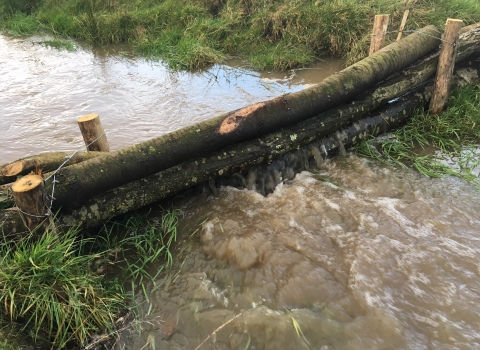
Nick Martin
Natural Flood Management
What is Natural Flood Management all about?
Natural flood management aims to reduce the downstream maximum water height of a flood (the flood peak) and/or to delay the arrival of the flood peak downstream, increasing the time available to prepare for floods. This is achieved by restricting the progress of water through a river catchment in 3 ways:
- Increasing soil infiltration and allowing water to soak away.
- Storing water by using natural features such as ponds, ditches or low lying land or by creating new ponds and areas to store water.
- Slowing water by increasing resistance to flow. For example, by planting trees on the floodplain or constructing “leaky dams” in a ditch, stream or river.
What is a “leaky dam”?
Leaky dams form naturally when large sections of trees fall into and across the ditch, stream or river. These large pieces of wood start to gather smaller sticks and leaves which allows some water through, but holds back some of the water in the stream during high flows. We can mimic nature by building leaky dams using locally sourced wood. The leaky dams can be pinned in place or dug into the bank to ensure they don't move around in high flows. Building a series of dams along a section of stream increases the effectiveness of the dams. Woody debris helps to create pools and riffles, providing a variety of habitats for fish and aquatic insects and attracts mammals and birds. Importantly leaky dams can slow the movement of silt and sediment downstream. Silt can increase flood risk by reducing the amount of space for water in a channel. Leaky dams are positioned high enough above the normal height of the stream or river to allow the water to travel downstream normally in a non-flood event whilst also allowing fish to move up and down the river easily.
Donate to the Wilder Waters appeal
Over the last 100 years, the UK has lost 90% of its wetland habitats, with more than one in ten freshwater and wetland creatures now at risk of extinction. Will you help us restore these vital lifelines and fund work for rivers and wetlands?
What's happening in Warwickshire?
Thanks to funding from the Environment Agency we are currently working with our partners the Environment Agency and Coventry City Council on two natural flood management projects. One project focuses on the river catchment around Fillongley and the second project is focussed on the Upper River Sherbourne catchment to the north of Allesley in Coventry. You can find out about the latest developments with the Upper Sherbourne Natural Flood Management project on this website here.
We want to say thank you to outdoor clothing suppliers Hilltrek for providing kit for our Wetlands team, helping them to keep working in challenging environments. Since 2018 Warwickshire Wildlife Trust has been leading a series of projects aiming to reduce the impacts of our rivers on flooding hotspots. Pioneering work in the newly emerging field of ‘Natural Flood Management’ has seen the team delivering different work across several rivers to reduce the risk of flooding.
Natural Flood Management takes many forms, including the planting of trees and hedgerows which help to catch and soak up rainwater. It can also include aerating soils, digging or expanding retention pools and swales to hold back additional water during storms and the installation of leaky barriers in watercourses to slow the flow. Thanks to kit provided by Hilltrek, the team can stay warm and dry and focus on their vital work.
What's going on elsewhere?
Wildlife Trusts around the country are working in partnership on natural flood management projects.
See what our friends in Gloucestershire have been doing to tackle flooding in the Stroud Valley.
This link will take you to a shorter 3 minute taster version.
Stroud District Council have also just released this fantastic video that gives a great explanation of the more technical details of natural flood management: watch it here.
Thanks to the Stroud Rural Sustainable Drainage Project for making these videos available.



